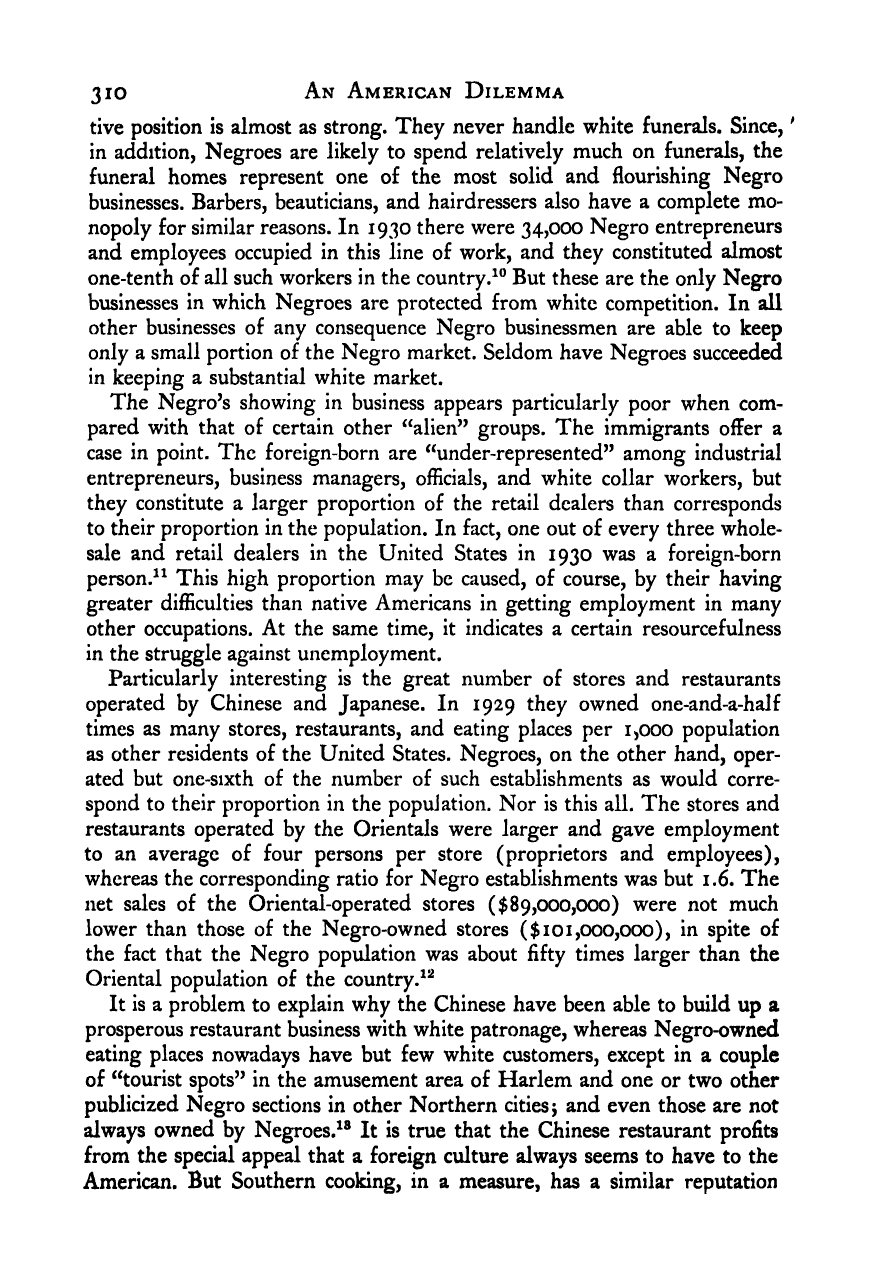Note: Gunnar Myrdal died in 1987, less than 70 years ago. Therefore, this work is protected by copyright, restricting your legal rights to reproduce it. However, you are welcome to view it on screen, as you do now. Read more about copyright.
Full resolution (TIFF) - On this page / på denna sida - IV. Economics - 14. The Negro in Business, the Professions, Public Service and Other White Collar Occupations - 2. The Negro in Business

<< prev. page << föreg. sida << >> nästa sida >> next page >>
Below is the raw OCR text
from the above scanned image.
Do you see an error? Proofread the page now!
Här nedan syns maskintolkade texten från faksimilbilden ovan.
Ser du något fel? Korrekturläs sidan nu!
This page has never been proofread. / Denna sida har aldrig korrekturlästs.
310 An American Dilemma
tive position is almost as strong. They never handle white funerals. Since,
’
in addition, Negroes are likely to spend relatively much on funerals, the
funeral homes represent one of the most solid and flourishing Negro
businesses. Barbers, beauticians, and hairdressers also have a complete mo-
nopoly for similar reasons. In 1930 there were 34,000 Negro entrepreneurs
and employees occupied in this line of work, and they constituted almost
one-tenth of all such workers in the country.^® But these are the only Negro
businesses in which Negroes are protected from white competition. In all
other businesses of any consequence Negro businessmen are able to keep
only a small portion of the Negro market. Seldom have Negroes succeeded
in keeping a substantial white market.
The Negro’s showing in business appears particularly poor when com-
pared with that of certain other “alien” groups. The immigrants offer a
case in point. The foreign-born are “under-represented” among industrial
entrepreneurs, business managers, officials, and white collar workers, but
they constitute a larger proportion of the retail dealers than corresponds
to their proportion in the population. In fact, one out of every three whole-
sale and retail dealers in the United States in 1930 was a foreign-born
person.^ ^ This high proportion may be caused, of course, by their having
greater difficulties than native Americans in getting employment in many
other occupations. At the same time, it indicates a certain resourcefulness
in the struggle against unemployment.
Particularly interesting is the great number of stores and restaurants
operated by Chinese and Japanese. In 1929 they owned one-and-a-half
times as many stores, restaurants, and eating places per 1,000 population
as other residents of the United States. Negroes, on the other hand, oper-
ated but one-sixth of the number of such establishments as would corre-
spond to their proportion in the popuJation. Nor is this all. The stores and
restaurants operated by the Orientals were larger and gave employment
to an average of four persons per store (proprietors and employees),
whereas the corresponding ratio for Negro establishments was but 1.6. The
net sales of the Oriental-operated stores ($89,000,000) were not much
lower than those of the Negro-owned stores ($101,000,000), in spite of
the fact that the Negro population was about fifty times larger than the
Oriental population of the country.^^
It is a problem to explain why the Chinese have been able to build up a
prosperous restaurant business with white patronage, whereas Negro-owned
eating places nowadays have but few white customers, except in a couple
of “tourist spots” in the amusement area of Harlem and one or two otW
publicized Negro sections in other Northern cities 5
and even those are not
always owned by Negroes.^® It is true that the Chinese restaurant profits
from the special appeal that a foreign culture always seems to have to the
American. But Southern cooking, in a measure, has a similar reputation
<< prev. page << föreg. sida << >> nästa sida >> next page >>